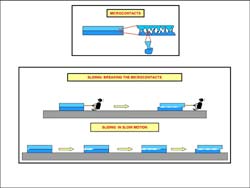New frictional motion study could provide tool for earthquake prediction

Top illustration shows two surfaces, greatly enlarged, with the microcontacts connecting them. In the middle illustration, the surfaces are starting to move against each other, with the microcontacts being broken. In the bottom drawing, sliding takes place as a slow-motion wave (white area) moves between the surfaces.
A new study on “waves (or fronts) of detachment” involved in the process of friction offers a new perspective on an old scientific puzzle and could provide a key to improving predictions of future earthquakes, say scientists at the Hebrew University of Jerusalem.
The work of the scientists, Prof Jay Fineberg, head of the Hebrew University’s Racah Institute of Physics, Dr Gil Cohen and graduate student Shmuel N Rubinstein, is described in an article in the journal Nature entitled “Detachment Fronts and the Onset of Dynamic Friction.”
Though studied for hundreds of years by names as distinguished as Leonardo da Vinci, and physicists Charles Augustin de Coulomb and Heinrich Rudolf Hertz, the study of friction remains as intriguingly current today as it was 500 years ago. Scientists have yet to fully decipher the fundamental mechanisms of friction – that is, what goes on when two surfaces begin to slide against one another?
Using near-field optics and recent technological advances in rapid imaging, the Hebrew University researchers have observed for the first time how three different types of waves govern the onset of friction. These waves, which function within the micron-thick interface between sliding surfaces, move at widely different velocities, from sonic and supersonic and down to slow speeds. The researchers showed that detachment – the actual separation of the points of microcontact between one surface and another that occurs during frictional movement – is governed mainly by the newly discovered, slow-wave phase.
These findings, says Prof Fineberg, have relevance for the issue of earthquake measurement and predictions, as well as for other future scientific and industrial applications. (Over 5 percent of losses due to both wear and energy dissipation in industry are due to friction, resulting in the loss of hundreds of billions of dollars a year worldwide, says Prof Fineberg.)
An earthquake is felt (and is measured seismically) as a sudden, rapid movement, or sliding, of tectonic plates in a frictional action, says Fineberg. However — based on the Hebrew University researchers’ findings — it would seem that it is actually the slow, “unfelt” or “silent” waves in the earth’s crust to which we should be paying closer attention and that are apparently the precursors of the frictional movement that we call earthquakes, says Fineberg.
These waves, though not actually felt, can be measured, Fineberg says, by applying the technology developed on a micro-scale in the Hebrew University laboratories to the macro-scale of sub-surface earth measurements. By doing so, it might be possible to prevent to some extent earthquake-related damage through warnings of approaching “detachment” of earth plates.
Media Contact
More Information:
http://www.huji.ac.ilAll latest news from the category: Earth Sciences
Earth Sciences (also referred to as Geosciences), which deals with basic issues surrounding our planet, plays a vital role in the area of energy and raw materials supply.
Earth Sciences comprises subjects such as geology, geography, geological informatics, paleontology, mineralogy, petrography, crystallography, geophysics, geodesy, glaciology, cartography, photogrammetry, meteorology and seismology, early-warning systems, earthquake research and polar research.
Newest articles

Peptides on Interstellar Ice
A research team led by Dr Serge Krasnokutski from the Astrophysics Laboratory at the Max Planck Institute for Astronomy at the University of Jena had already demonstrated that simple peptides…

A new look at the consequences of light pollution
GAME 2024 begins its experiments in eight countries. Can artificial light at night harm marine algae and impair their important functions for coastal ecosystems? This year’s project of the training…

Silicon Carbide Innovation Alliance to drive industrial-scale semiconductor work
Known for its ability to withstand extreme environments and high voltages, silicon carbide (SiC) is a semiconducting material made up of silicon and carbon atoms arranged into crystals that is…




















